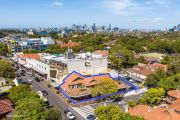
Vicinity’s bet that bigger is better brings higher in-store spending
Vicinity Centres’ strategy of investing in destination shopping centres, such as Melbourne’s Chadstone, and selling non-core assets is paying off as shoppers take their spending to larger malls and storefronts.
In its interim FY25 results, the listed property giant reported a post-tax net profit of $492.6 million, a 120 per cent boost from a year ago, driven by the value of its malls increasing by $174 million. Funds from operations – or operating earnings – remained stable at $344.1 million equating to 7.65¢ per security.

“Our investment strategy remains anchored by our strong conviction that premium fortress style assets located in great trade areas … have the potential to deliver superior and sustained income and valued growth over time,” Vicinity chief executive Peter Huddle told investors on Wednesday.
Vicinity has spent the past 18 months repositioning its property portfolio to focus on premium shopping centres. Over that time, it divested about $1 billion of smaller suburban and regional shopping centres. It is set to offload another $180 million worth of these non-core assets in the next six months.
At the same time, the shopping centre operator has spent $727 million acquiring Perth’s Lakeside Joondalup and Sydney’s Chatswood Chase – the former acquired during the interim FY25 period.
The acquisitions, combined with about $1 billion being deployed redeveloping larger malls such as Chadstone Shopping Centre and Chatswood Chase, are a big part of Vicinity’s belief that building bigger is better.
Where shoppers are spending
That investment theme was bearing fruit with premium centre sales productivity more than 20 per cent higher than its portfolio average at nearly $16,000 per square metre.
Overall, Vicinity shopping centres posted a 2 per cent increase in retail sales during the six months to December.
The strong sales performance of those assets has culminated in Vicinity’s premium assets posting a 5.7 per cent growth in comparable net property income, which was 150 basis points above its portfolio average.
Its premium leasing spreads – the difference in rents between old and new agreements – of positive 6.7 per cent was also 320 basis points higher than the portfolio average. Shopping centres such as Chadstone delivered a 10.5 per cent positive leasing spread.
A big driver of shoppers flocking to those larger shopping centres has been Vicinity’s shift to housing more mini major tenants – a category of retailers that includes Kmart, Target, H&M, Zara and Uniqlo – demanding more space, Huddle said.
For example, Lululemon recently opened stores at Chadstone and Emporium Melbourne.
“Our mini major stores significantly outperformed specialty sales in the period, which essentially reflects successful remixing activity. It comes back to increased retailer demand for larger stores in premium assets,” he said.
“In terms of near-term outlook for the retail sector, we welcome the RBA decision to lower rates, which together with its resilient employment market, should support continual improvement in consumer spending.”
The flight to quality shopping centres is also reflected in where Vicinity has experienced its strongest valuation increases. Its flagship Chadstone mall posted a valuation increase of 1.3 per cent, while its seven premium CBD malls increased in value by 1.4 per cent. Vicinity’s eight outlet centres’ value also increased by 1.7 per cent.
By comparison, its 35 malls across the regional and subregional categories increased in value by 0.5 per cent and 1.1 per cent, respectively.
According to Citi analyst Howard Penny, Vicinity’s results are “strong and should be well received by the market on a relative basis”.
He said, however, that the anticipated liquidity in the market from the Goodman $4 billion capital raise will weigh on the overall share price performances of the property sector in the short term.
Vicinity has reaffirmed its earnings guidance, with its funds from operations per security in the range of 14.5¢ to 14.8¢, for the 2025 financial year. The FFO combined with a $174 million increase in the company’s assets led to the increased net profit.
Vicinity has also declared an interim distribution of 5.95¢ per stapled security, which was in line with expectations.
Shareholders can reinvest those interim distributions into new Vicinity securities as part of the company’s distribution reinvestment plan announced last month.











